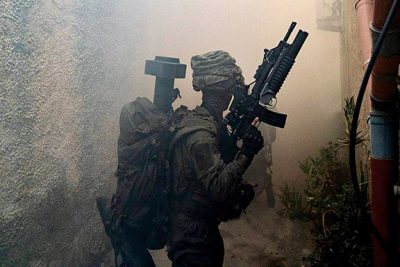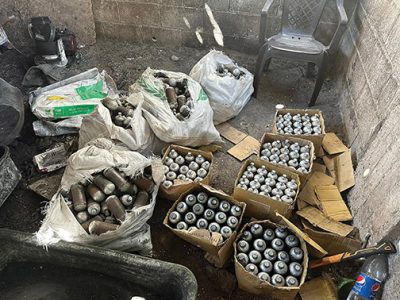×


We have detected your country as:
Please click here to go to the USA website or select another country from the dropdown list.
by: Kate Norman, BFP Staff Writer
Israel’s biblical heartland is facing a big problem. In the land of milk and honey, terrorists have established a hornet’s nest from which springs a never-ending stream of violence.
The base is Jenin, a hotbed of terrorism in northern Samaria. Over the past year, the Israel Defense Forces (IDF) said in July, residents of Jenin and the surrounding area conducted some 50 shooting attacks against Israeli civilians and security personnel, while 19 terrorists on the run from security forces sought refuge in the nest.
A bloody terror wave began early in 2022, which saw 19 people across Israel killed between March and May of that year. Another surge of violence erupted early in 2023, and since the beginning of this year, terrorists have murdered two dozen Israelis.
 Israeli security forces responded by conducting near-nightly counterterror raids—focusing on Jenin and Nablus—to combat terrorism at its source. But when the IDF soldiers arrived in these terror hotbeds, particularly in Jenin, they were often greeted by armed gunmen, ensuing in fierce shootouts.
Israeli security forces responded by conducting near-nightly counterterror raids—focusing on Jenin and Nablus—to combat terrorism at its source. But when the IDF soldiers arrived in these terror hotbeds, particularly in Jenin, they were often greeted by armed gunmen, ensuing in fierce shootouts.
Jenin is home to a horde of terror groups. These include Hamas, the Iran-backed terror group that reigns in the Gaza Strip; the Palestinian Islamic Jihad (PIJ), the second-largest terror group in Gaza, also backed by Iran; and a few smaller terror factions, including ones with ties to Fatah, the leading secular Palestinian political party that makes up a majority of the Palestinian Authority (PA). These three—Hamas, the PIJ and the PA—are the frontrunners in the power play for Palestinian authority.
Determined to bring the hornet’s nest under control, Israel launched a two-day operation in Jenin on July 3. Between 1,000 and 2,000 Israeli soldiers poured into the terror hotspot during the two days, according to differing reports, in addition to drones and aircraft. The military announced that during the 48-hour period, it had discovered and destroyed eight weapons storage sites—including one in a mosque—six explosive manufacturing sites, 11 improvised explosive devices, three war rooms used to spy on the IDF and an underground tunnel network.
The IDF focused mainly on a local branch of the PIJ, known as the Jenin Battalion, in addition to other terror groups operating in the area. Unlike the nightly counterterror raids, the Israeli forces were met with little resistance, the Times of Israel reported, as most terrorists had fled the area. This gave the Israeli forces space to find and neutralize the terror sites, crippling—though not completely eradicating—the terrorist presence in the city.
Israel’s top brass hailed the operation as a success. Israeli Defense Minister Yoav Gallant declared that Israel “fully achieved” the goal of restoring freedom for Israeli forces to operate in Jenin. But he warned that the operation is “not the final word as far as we’re concerned.”
Prime Minister Benjamin Netanyahu echoed this warning, adding that the operation was “not a one-time thing” and that the Jewish state will continue taking necessary action to ensure that Jenin does not become a “haven for terror.”
An Al Jazeera columnist penned a diatribe on the IDF’s two-day counterterror operation in Jenin, describing it as an Israeli attack to “terrorize and traumatize Palestinians in the occupied West Bank [Judea and Samaria] for two horrendous days.” The columnist, Andrew Mitrovica, also berated the Western media, accusing them of lying “to defend Israel, no matter what it does.”
Mitrovica then went on to paint a bloody picture of Israeli atrocities against innocent Palestinian refugees. Twelve Palestinians were killed during the operation—all confirmed by the IDF to be terrorist militants—and “scores more were hurt and damaged in mind and spirit,” Mitrovica lamented.
The operation was, the columnist insisted, “further evidence of the policy of apartheid pursued by a succession of Israeli governments designed…to impose ethnic supremacy in occupied Palestine and to crush Palestinians into ghettos with grinding, inhuman efficiency.”
Yet Mitrovica failed to address the purpose behind Israel’s operation. And it wasn’t to impose ethnic supremacy over innocent Palestinians. This wild accusation glosses over the reality of Jenin as host to a multitude of terrorist activity, a haven for terrorists and a launching pad for attacks against Israelis.
 But Jenin has become a power vacuum of sorts for the Palestinian people. A month after the operation, a gunfight broke out between the Palestinian factions in the streets of the hornet’s nest, as the PA tried to quell rioting by PIJ- and Hamas-affiliated crowds protesting the PA’s arrest of a Jenin Battalion member.
But Jenin has become a power vacuum of sorts for the Palestinian people. A month after the operation, a gunfight broke out between the Palestinian factions in the streets of the hornet’s nest, as the PA tried to quell rioting by PIJ- and Hamas-affiliated crowds protesting the PA’s arrest of a Jenin Battalion member.
The PA traded slurs with the PIJ and Hamas, with the PA accusing its two rivals of stirring up trouble in Israel on behalf of Iran, and the PIJ and Hamas accusing the PA of acting on Israel’s behalf.
This unrest came just a few days after a meeting in Egypt of Palestinian factions to settle on a unified response to Israel’s operation in Jenin. The meeting, however, was boycotted by the PIJ and other small factions, the Jerusalem Post noted, in protest of the PA arresting terrorists in Jenin.
Though the PA incites violence against Israel and financially rewards terrorists and their families in its “Pay-for-Slay” policy, the organization also coordinates with Israel on certain matters, including security.
Perhaps Jenin will always be the Wild West of the biblical heartland. The July operation was a decisive victory in Israel’s battle against terrorism in the biblical heartland, but the threat is not completely eradicated. Jenin continues to be a lightning rod for Israeli–Palestinian clashes as well as Palestinian against Palestinian clashes amid the Palestinian power play. But as the operation proved, Israel will not allow the hornet’s nest to get out of hand, especially when the hornets are out to spill Jewish blood.
Photo Credit: Click on photo to see photo credit
Photo License: Weapons cache found in Jenin
Photo License: Jenin incursion
All logos and trademarks in this site are property of their respective owner. All other materials are property of Bridges for Peace. Copyright © 2025.
Website Site Design by J-Town Internet Services Ltd. - Based in Jerusalem and Serving the World.